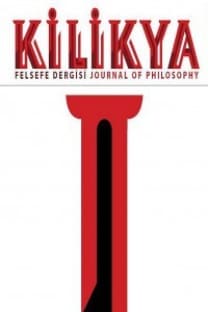Platon ve Heidegger’de Aletheia ve Sanat Yapıtı İlişkisi
Gizlenmemişlik üzerine ontolojik ve epistemolojik bir farkındalığa karşılık gelen aletheia, Platon ve Heidegger›in düşünce dizgesinde temel bir konuma sahiptir. Her iki düşünür de kavramın yalnızca kökenine ve olanağına ilişkin bir inceleme yapmakla kalmamış aynı zamanda kavramın sanat yapıtı ile olan ilişkisinde açığa çıkan varoluş biçimlerinin kökensel değerine ilişkin bir sorgulama gerçekleştirmişlerdir. Biliş ve varoluş arasındaki ilinti, kendisinden hakikatin bilinebileceği varoluş biçimleri zemininde değerlendirildiğinde Platon için insanın akıl ve beden kapasitesinin kendi ontik ve epistemolojik varlığıyla doğrudan ilişkilendirildiği hiyerarşik bir onto-pistemolojik kavrayışa; Heidegger için ise ontik olanın, yalnızca ontik olan olması yeterliliğinde bilmeye kapı araladığı ve bu sayede de sanat yapıtı varoluşu dahil her bir varoluşun bilme edimiyle ilişkilendirilebildiği bir kavrayışa çıkmaktadır.
Anahtar Kelimeler:
Aletheia, Sanat Yapıtı, Platon, Heidegger, Bilgi
Aletheia and Artwork Relationship in Plato and Heidegger
The concept of Aletheia which corresponds to an epistemological and ontological awareness over about the disclosedness, occupies fundemental places in the thought-systems of both Heidegger and Plato. Either of the philosophers have not only made an examination on the origin and the possibility of this concept; but they have also made an inquiry on the original value of its existence-forms, which are revealed in the relationship of the concept with the work of art. The relation between cognition and existence is a hierarchical onto-epistemological conception of Plato, where the human mind and body capacity is directly related to its ontic and epistemological existence when evaluated in the context of the forms of existence that it can know the truth from; for Heidegger, the ontic opens a door to knowing that because it merely an ontic is, and in this way comes an understanding that every existence, including the existence of the artwork, can be associated with the act of knowing.
Keywords:
Aletheia, The Work of Art, Plato, Heidegger, Knowledge,
___
- Aristoteles. (1996). Metafizik, (Çev. A. Arslan), İstanbul: Sosyal Yayınları
- Brun, J. (2007). Platon Ve Akademia, (Çev. I. Yerguz), Ankara: Dost Yayınları
- Halliwell, S. (2002). The Aesthetics Of Mimesis- Ancient Texts and Modern Problems, New Jersey: Princeton University Press
- Hard, R. (2004). The Routledge Handbook Of Greek Mythology, New York: Routledge Taylor & Francis Group
- Heidegger, M. (1977). Der Ursprung des Kunstwerkes, Frankfurt am Main: Vittorio Klostermann
- Heidegger, M. (2008). Varlık Ve Zaman, (Çev. K.H. Ökten),Istanbul: Agora Kitaplığı
- Moles, J. N. (2015). Aletheia: Remembering And Enlivening, Journal Of Applied Hermeneutics, April -22
- Monchamp, M. (2008). Aletheia- Truth Of The Past, Journal Humanity
- Neumaier, O. (2010). Are Works of Art Simply Imitations Of Shadows? (Ed. Diana Teters): Metamophoses Of The Worlds: Traces, Shadows, Reflections, Echoes and Metaphors, pp: 308-326
- Peters, F. (2004). Antik Yunan Felsefesi Terimleri Sözlüğü, (Çev. Hakkı Hünler), İstanbul: Paradigma Yayınları
- Platon, (1975). Diyaloglar, (Çev. Hürriyet Kolektif), Istanbul: Hürriyet Yayınları
- Platon, (2000). Symposion- Şölen, (Çev. Cenap Karakaya), İstanbul: Sosyal Yayınları
- Platon, (2007). Yasalar, (Çev. S. Babür, C. Şentuna), İstanbul: Kabalcı Yayınları
- Platon, (2009). Devlet, (Çev. S. Eyüboğlu- M. Cimgöz), İstanbul: İş Bankası Kültür Yayınları
- Platon, (2010). Diyaloglar, (Çev. Kolektif), İstanbul: Remzi Kitabevi
- Yayın Aralığı: Yılda 2 Sayı
- Başlangıç: 2014
- Yayıncı: Eray Yağanak
Sayıdaki Diğer Makaleler
Martin Heidegger'in Teknoloji Görüşü: Özcü Eleştiriye Bir Cevap
Değer Çatışmaları Sorununda Bir Olanak: Duyguların Eğitimi
Platon ve Heidegger’de Aletheia ve Sanat Yapıtı İlişkisi
John Locke’ta Sözcüklerin Kurulumundan Toplumun Kurulumuna Uzlaşım Unsurunun Rolü
Stalnaker’s Hypothesis: A Critical Examination of Hájek’s Counter Argument
